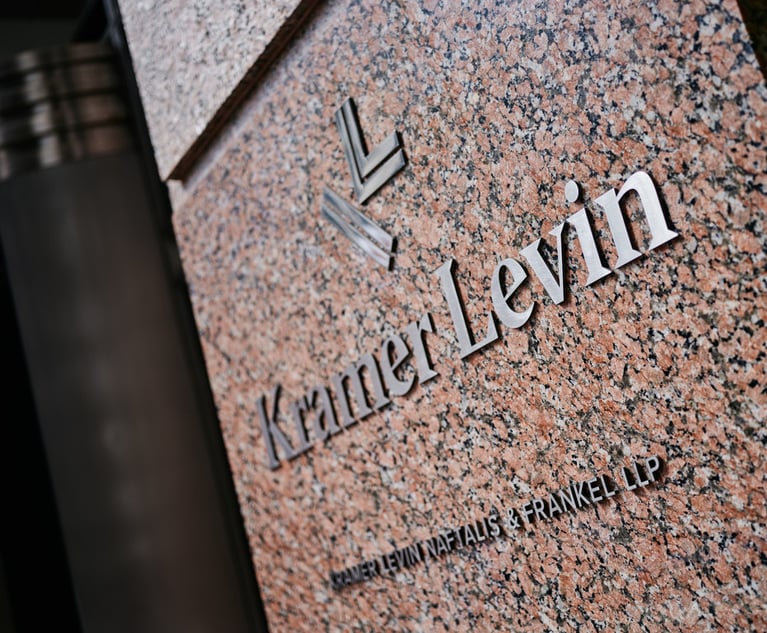Proffitt and loss
Thacher Proffitt & Wood real estate partner Donald Simone was at his desk on the 40th floor of the World Trade Center's south tower early on 11 September, 2001, pushing to close a deal, when United Airlines Flight 175 crashed into the building about three dozen floors above."When it hit, my whole office moved," Simone recalls. With the electricity off and ceiling tiles falling, he made his way to a stairwell and then to safety.
March 18, 2009 at 09:34 PM
16 minute read
 Putting almost all of its chips on mortgage-backed securities work paid off big for Thacher Proffitt & Wood. Then the market turned, and so did the firm's luck. David Bario reports
Putting almost all of its chips on mortgage-backed securities work paid off big for Thacher Proffitt & Wood. Then the market turned, and so did the firm's luck. David Bario reports
Thacher Proffitt & Wood real estate partner Donald Simone was at his desk on the 40th floor of the World Trade Center's south tower early on 11 September, 2001, pushing to close a deal, when United Airlines Flight 175 crashed into the building about three dozen floors above.
"When it hit, my whole office moved," Simone recalls. With the electricity off and ceiling tiles falling, he made his way to a stairwell and then to safety.
The attacks obliterated Thacher's New York office, but none of the 310 Thacher lawyers and support staff who worked in the World Trade Center died on 9/11. Afterwards, from borrowed offices and temporary space, the firm kept working on the securitisation deals that had become its lifeblood. In fact, Thacher had its best financial results after the disaster, with profits more than doubling in just three years. "There was a sense that if we could get through [9/11], we could get through anything," says Robert McCarthy, a former partner in Thacher's structured finance group.
He was wrong. Less than a decade later, Thacher, a New York institution since 1848, is gone. The firm's partners made millions fuelling a market for securitised mortgages that, it now turns out, nearly sank the global economy. Thacher got hooked on these lucrative deals, allowing structured finance to dominate the firm's business model and refusing to consider a merger until the market had collapsed. In its final years, to keep up with the securitisation boom, Thacher financed a massive growth spurt with debt that reached $30m (£21.4m) and, after the market turned, left a once fiercely independent firm at the mercy of its creditors.
It is not a pretty story. "I find it personally embarrassing as a senior partner that a 160-year-old law firm that spawned my career collapsed under my watch," says former partner Jeffrey Murphy.
Still, the partners who made up Thacher's old guard say the speed of the financial meltdown left them no time to adjust. They emphasise that the majority of Thacher's partners made an extraordinary effort to stay together, and to some extent, they succeeded. Forty of them, along with 61 associates and 60 staff members, remain in their same downtown offices overlooking Ground Zero – though the sign on the door now says Sonnenschein Nath & Rosenthal.
Before the secondary market for mortgage loans took off in the 1980s, Thacher had a reputation for being staid, even a little sleepy. Its lawyers performed mainly run-of-the mill corporate work and maintained a ship finance practice, a vestige of Thacher's beginnings as an admiralty firm.
Thacher's transformation began with a phone call. In the late 1970s, legendary bond trader Lewis Ranieri, then at Salomon Brothers, was just starting to wade into the mortgage markets.
In 1978 Salomon's Daniel Kearney phoned the chair of Thacher's real estate group, Kurt Lore, for advice on dealing with the pools of mortgages Salomon was buying. In the story's usual telling, Lore nearly did not return the call, thinking that it was a cold call from a broker.
But Lore did return the call. With his encouragement, then-associate Daniel Driscoll began building a practice to serve Salomon. In those days, Salomon was buying mortgages at a discount, structuring them as investments for other banks, and reselling them for a tidy profit – say, a 5% markup on a $100m (£69m) bundle of mortgages. Many of the firm's clients at Salomon soon migrated to places such as Credit Suisse Group, First Boston and Merrill Lynch, to form their own mortgage desks, and the practice quickly spread. By the late 1980s, new legislation had paved the way for mortgages to be packaged more easily into securities and held by national banks, and the first securities backed by subprime mortgages were being traded. Into the 1990s the structures became more complex, the transactions grew larger and more kinds of debt – from credit cards to auto loans to equipment leases – were securitised.
The lawyers at Thacher kept their early edge, so dominating the market that the standard paperwork used by mortgage traders came to be known as 'Thacher docs' and 'TP&W forms'. By 2000, Thacher's structured finance lawyers and the real estate and tax lawyers who worked with them had become a firm within a firm, partners say. The legal work required to package mortgage-backed securities was complex and labour-intensive – but also largely routine. A few partners supervising a large number of associates could generate enormous revenues. It was an efficient, highly profitable machine.
When the subprime mortgage boom arrived the machine cranked into an even higher gear. In June 2003 the Federal Reserve nudged the federal funds rate down to 1%, and low interest rates fuelled a rush into alternative investments. The demand for securities backed by subprime mortgages and other assets skyrocketed. Before 1998 Thacher had not ranked among The Am Law 200. By 2005 it was the 32nd most profitable partnership in the country. Paul Tvetenstrand, a mortgage-backed securities lawyer who took over as managing partner in 2003, presided over a dramatic increase in head count, from 177 lawyers in 2003 to 350 in 2007. By 2007, says Tvetenstrand, the structured finance department accounted for 40% of the firm's head count and as much as 55% of its revenues.
But those numbers do not capture how hyper-focused the firm had become on securitisations and closely related work. Much of Thacher's real estate department was part of the same revenue-generating machine, structuring mortgage loans for investment banks that in turn relied on lawyers in the structured finance group to securitise them. All in all, Tvetenstrand says, as much as 70% of the firm's revenue came from those combined practices, with corporate and litigation contributing most of the rest.
The groups that made up Thacher's securitisation apparatus tended to be the most heavily leveraged at the firm – with an associate-to-partner ratio of 6:1 in the structured finance group, according to former partners. And a lot of those associates became partners. A former senior Thacher partner says: "The result was that we wound up with an abundance of uni-dimensional junior partners, and when the music stopped, there was a lot of deadweight."
The insurance proceeds from 9/11 had paid for lavish new offices: three impressively appointed floors at Manhattan's World Financial Center. Starting in 2005, to house its growing workforce, Thacher leased two more floors, renovating them to match the existing floors. According to several former partners, the expansion cost close to $10m (£7.1m) per floor. To pay for the new space, the firm turned to Citi, taking on substantial debt for the first time.
Thacher made some efforts to diversify through lateral hires. For the most part, however, the laterals had practices firmly rooted in the capital markets, like Robert Villani, whose practice consisted largely of securitising healthcare receivables, or William 'Butch' Cullen, whose practice focused on commercial mortgage-backed securities. "It was hardly the kind of diversification the firm could count on when the downturn hit," says a partner who left Thacher in 2008.
The firm's greatest growth continued to be in structured finance and real estate, particularly residential mortgage-backed securities (RMBS). Tvetenstrand says it couldn't be helped. "What were we going to do – call up our clients and say, 'Please don't send us any more business, you're ruining our business model'?" he says.
A handful of former partners are more critical. "The guys who were really into RMBS and expecting to be making a lot of money didn't want laterals diluting their profits for the sake of [practice] diversity," says one. "They had what amounted to a controlling interest in the firm, and they figured they'd rather just ride the wave."
The collapse of the subprime bubble and the ensuing credit crisis did not just hurt Thacher's clients. It wiped many of them out. New Century Financial filed for bankruptcy in April 2007. American Home Mortgage Investment followed suit in August, and Countrywide Financial nearly suffered the same fate before being acquired by Bank of America in October 2008.
Former partners say that by August 2007 the firm's securitisation practice had hit a wall. The firm had begun to borrow more heavily from its lines of credit from Citi and Wachovia Corporation to meet basic expenses like payroll and rent. "By the summer it became clear that the crisis was going to be fairly serious though, of course, we had dealt with downturns before," says McCarthy. "By November, people were starting to worry about '08." That month the firm laid off 24 associates – the first of a series of five cuts over the next 12 months.
Despite a 22% decline in partner profits in 2007 from 2006, at the end of 2007 the firm as usual distributed partner bonuses equal to 15% of the firm's revenue. Many partners still expected to weather this downturn as they had weathered smaller slowdowns in the past.
By early 2008, however, it was clear that this would be a very tough year, and the firm began to hunker down. Partners each made an $80,000 (£57,000) capital contribution in January. The partnership, which was compensated on a point system ranging from four to 20 points (with a point value well over $100,000 (£71,000) in peak years), agreed to a cap of 12 points to distribute profits more equitably. In addition, every year Thacher held back close to 15% of revenues until the following 15 April as a reserve for unanticipated expenses. This time, instead of releasing the funds after April, the firm asked partners to leave most or all of their holdback with the firm indefinitely.
In March 2008 Bear Stearns collapsed with $46bn (£32bn) in mortgage debt on its books, avoiding bankruptcy in a fire sale acquisition by JPMorgan Chase Bear Stearns had been Thacher's largest client, supplying more than $10m (£7.1m) of annual billings. March 2008 also marked the beginning of Thacher's own credit crisis. In securing its loans from Citi, the firm had signed a covenant specifying the ratio of debt to work-in-progress and accounts receivable. Thacher now breached the covenant, technically defaulting on its loans (it violated a second covenant on partner head count a few months later). The bank referred Thacher's account to its internal workout group and brought in outside counsel Jonathan Landers (then at Gibson Dunn & Crutcher).
"They had their brass-knuckles team assembled pretty early on," remembers one former Thacher partner.
Partners used to Thacher's vaunted independence now found themselves beholden to the bank. Not only could Thacher itself be forced into dissolution at any time, partners had assumed liability for 10%-20% of the $30m (£21m) the firm had borrowed. In addition, most of the partnership borrowed some or all of their final $80,000 (£57.1m) contribution to the firm through a capital loan program, former partners say.
Beginning in 2007 and throughout 2008, Thacher's partner ranks shrank by 30%. All but one of the defecting partners were laterals who joined Thacher in fatter times.
With associate ranks depleted by layoffs and departures, Thacher no longer required the extra two floors it had needed just the year before. Given the state of the market, however, the firm could not find a tenant to sublet the space.
Midway through 2008, in June, Thacher shook up its management to confront the crisis. Tvetenstrand continued as the managing partner and chairman of the executive committee, which would handle day-to-day administration of the firm. Responsibility for Thacher's future, however, now fell to a new eight-partner planning committee headed by Bob McCarthy.
Most former Thacher partners contacted for this article praised Tvetenstrand's post-9/11 leadership. Still, many say, it was no accident that he was now effectively sidelined from decisions affecting Thacher's future. After all, says one former partner, "he was captain of the ship when it started sinking."
As for Tvetenstrand, he stands by his decisions both before and during 2008. "You have a fiduciary responsibility to do the best that you can for as many people as you can," Tvetenstrand says. "That's what I did."
Facing an internal deadline of 31 December before dissolving the firm – Citi would eventually make this deadline explicit – the firm hired Altman Weil's Ward Bower and Bruce MacEwen to help chart a way forward. Late in July the consultants delivered a simple verdict: merge with a large firm or dissolve. The consultants presented a list of potential merger candidates, including Bingham McCutchen, Reed Smith and King & Spalding.
By all accounts, the glue holding Thacher together at that point was real, and as much personal as anything else. As partners who had joined the firm after 2001 continued to leave, many of the remaining partners dug in. "The core very much wanted to stay together," says McCarthy. "There was a bond among the core of the partners that had been around on 9/11 that really held them together," says Richard Hans, a Thacher litigator who joined DLA Piper in December 2008. "They really did work together in a way that is rare in New York for a firm of that size."
By August, Atlanta-based King & Spalding had emerged as the suitor most eager to pursue a merger. It had long struggled to build its New York office, say former Thacher partners and outside observers, and Thacher offered a cohesive group with nearly unmatched strength in the capital markets.
But the negotiations moved slowly, and on 9 December, after five months of talks, King & Spalding pulled out. Thacher's bankers at Citi – who according to former partners had been distracted by the dissolutions of Heller Ehrman and Thelen – now demanded repayment by 31 December. The planning committee was left scrambling for a Plan B.
Partners faced some harsh economic realities: the firm's 2008 revenues reached only $121m (£71m), down nearly 40% from 2007. Aside from $115,000 (£82,000) each – an accumulated 11-and-a-half months of partners' standard $10,000 draw – partners would take home nothing in 2008. Partners were liable for a portion of the firm's $30m debt, along with whatever they borrowed for their final capital contributions. Partners who had left their 2007 holdback with the firm – a sum that ranged from $100,000 to several hundred thousand dollars – would never see any of it.
Worried that the King & Spalding merger might fall through, a handful of partners, led by Donald Simone and Jonathan Forstot, had started talking with Sonnenschein chairman Elliott Portnoy immediately before Thanksgiving. Just as King & Spalding was withdrawing from the merger talks, McCarthy and Portnoy had their first direct discussions. On 14 December, more than a dozen senior Thacher partners joined a conference call with Sonnenschein's policy committee.
"I went into that call thinking this was a Hail Mary play," remembers Simone. But the call went well, and Thacher partners began work on a term sheet for the deal. By late in the evening on 18 December, Thacher's planning committee and Sonnenschein's policy committee had reached an agreement.
Sonnenschein acquired40 Thacher partners,60 associates and 61 staff members. It shouldered the costs of 60 day-severance payments for 59 Thacher associates and 60 staff members, and it agreed to absorb more than 25% of the costs of breaking Thacher's leases on two floors at the World Financial Center and its offices in Washington DC and White Plains, New York. The new Sonnenschein partners, exactly half of whom were granted equity status, included most of Thacher's structured finance department and members of the practice groups who worked most closely with them, along with a handful of additional partners.
Just 15 partners opted out or were not included in the deal with Sonnenschein. For the most part, they were either on the sidelines of Thacher's capital markets juggernaut or had made partner late in the boom. One has since found a position as general counsel at a former client. One more was invited to join his former colleagues at Sonnenschein in early February. The majority of the partners who made the move to Sonnenschein were the members of Thacher's executive and planning committees – the core, as former partners like to say – and their service partners.
This was the largest lateral acquisition Sonnenschein had ever completed, and it was done fast, under time pressure, in a recession. Still, Portnoy says he is not worried about carrying the Thacher group while the capital markets continue to hibernate. "This is not a group that is sitting around waiting for the economy to turn," he insists. He says that former Thacher partners are fielding government work, such as existing assignments for the Department of Education and advising the Federal Deposit Insurance Corporation in its acquisition of IndyMac Federal Bank FSB. And when the economy rebounds, Portnoy says, Sonnenschein now has a dramatically larger transactional practice in New York. For now, the new Sonnenschein partners are keeping as busy with government work and resecuritising existing loans – as well as trying to collect from Thacher clients to help pay more than $25m (£17.8m) of remaining bank debt.
About a year ago, as Thacher's financial situation steadily worsened, Tvetenstrand received an unexpected call from a woman in Montana. The caller was the great grand-niece of name partner Archibald Thacher, looking to sell his gold pocket watch. The 9/11 attacks had destroyed nearly all the artifacts of Thacher's beginnings, including model ships and oil paintings of the founders. Tvetenstrand says he jumped at the chance to reclaim a piece of the firm's past. Now at Sonnenschein, he still has the watch. Unlike Thacher, it is still ticking. "I don't know what to do with it," he says.
A version of this article first appeared in The American Lawyer, Legal Week's sister title.
This content has been archived. It is available through our partners, LexisNexis® and Bloomberg Law.
To view this content, please continue to their sites.
Not a Lexis Subscriber?
Subscribe Now
Not a Bloomberg Law Subscriber?
Subscribe Now
NOT FOR REPRINT
© 2024 ALM Global, LLC, All Rights Reserved. Request academic re-use from www.copyright.com. All other uses, submit a request to [email protected]. For more information visit Asset & Logo Licensing.
You Might Like
View All
To Thrive in Central and Eastern Europe, Law Firms Need to 'Know the Rules of the Game'
7 minute read

GOP's Washington Trifecta Could Put Litigation Finance Industry Under Pressure
Trending Stories
- 1Gibson Dunn Sued By Crypto Client After Lateral Hire Causes Conflict of Interest
- 2Trump's Solicitor General Expected to 'Flip' Prelogar's Positions at Supreme Court
- 3Pharmacy Lawyers See Promise in NY Regulator's Curbs on PBM Industry
- 4Outgoing USPTO Director Kathi Vidal: ‘We All Want the Country to Be in a Better Place’
- 5Supreme Court Will Review Constitutionality Of FCC's Universal Service Fund
Who Got The Work
Michael G. Bongiorno, Andrew Scott Dulberg and Elizabeth E. Driscoll from Wilmer Cutler Pickering Hale and Dorr have stepped in to represent Symbotic Inc., an A.I.-enabled technology platform that focuses on increasing supply chain efficiency, and other defendants in a pending shareholder derivative lawsuit. The case, filed Oct. 2 in Massachusetts District Court by the Brown Law Firm on behalf of Stephen Austen, accuses certain officers and directors of misleading investors in regard to Symbotic's potential for margin growth by failing to disclose that the company was not equipped to timely deploy its systems or manage expenses through project delays. The case, assigned to U.S. District Judge Nathaniel M. Gorton, is 1:24-cv-12522, Austen v. Cohen et al.
Who Got The Work
Edmund Polubinski and Marie Killmond of Davis Polk & Wardwell have entered appearances for data platform software development company MongoDB and other defendants in a pending shareholder derivative lawsuit. The action, filed Oct. 7 in New York Southern District Court by the Brown Law Firm, accuses the company's directors and/or officers of falsely expressing confidence in the company’s restructuring of its sales incentive plan and downplaying the severity of decreases in its upfront commitments. The case is 1:24-cv-07594, Roy v. Ittycheria et al.
Who Got The Work
Amy O. Bruchs and Kurt F. Ellison of Michael Best & Friedrich have entered appearances for Epic Systems Corp. in a pending employment discrimination lawsuit. The suit was filed Sept. 7 in Wisconsin Western District Court by Levine Eisberner LLC and Siri & Glimstad on behalf of a project manager who claims that he was wrongfully terminated after applying for a religious exemption to the defendant's COVID-19 vaccine mandate. The case, assigned to U.S. Magistrate Judge Anita Marie Boor, is 3:24-cv-00630, Secker, Nathan v. Epic Systems Corporation.
Who Got The Work
David X. Sullivan, Thomas J. Finn and Gregory A. Hall from McCarter & English have entered appearances for Sunrun Installation Services in a pending civil rights lawsuit. The complaint was filed Sept. 4 in Connecticut District Court by attorney Robert M. Berke on behalf of former employee George Edward Steins, who was arrested and charged with employing an unregistered home improvement salesperson. The complaint alleges that had Sunrun informed the Connecticut Department of Consumer Protection that the plaintiff's employment had ended in 2017 and that he no longer held Sunrun's home improvement contractor license, he would not have been hit with charges, which were dismissed in May 2024. The case, assigned to U.S. District Judge Jeffrey A. Meyer, is 3:24-cv-01423, Steins v. Sunrun, Inc. et al.
Who Got The Work
Greenberg Traurig shareholder Joshua L. Raskin has entered an appearance for boohoo.com UK Ltd. in a pending patent infringement lawsuit. The suit, filed Sept. 3 in Texas Eastern District Court by Rozier Hardt McDonough on behalf of Alto Dynamics, asserts five patents related to an online shopping platform. The case, assigned to U.S. District Judge Rodney Gilstrap, is 2:24-cv-00719, Alto Dynamics, LLC v. boohoo.com UK Limited.
Featured Firms
Law Offices of Gary Martin Hays & Associates, P.C.
(470) 294-1674
Law Offices of Mark E. Salomone
(857) 444-6468
Smith & Hassler
(713) 739-1250










